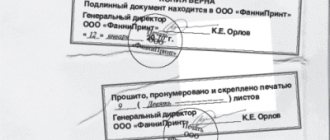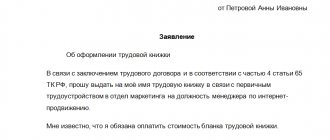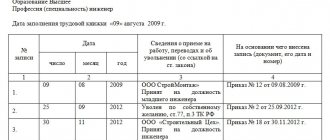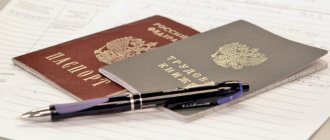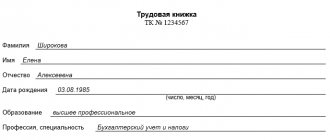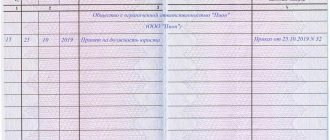A work book is one of the most important documents for an employee. The legislation imposes the obligation on the employer to enter current and correct data into it based on documents received from the employee. Therefore, any inaccuracy or error in the work book entries about the employee, place of work or other invalid information must be corrected. In addition, the data in the work book must be updated if it becomes outdated (for example, if the employee received a new education, changed his last name, etc.).
Legal basis
Entries in work books and their adjustments are made according to the rules established by:
- Labor Code of the Russian Federation;
- Decree of the Government of the Russian Federation of April 16, 2003 No. 225 “On work books”;
- Resolution of the Ministry of Labor of Russia dated October 10, 2003 No. 69 “On approval of the Instructions for filling out work books.”
If the employer ignores the procedure for making corrections in work books, the organization as a whole and the officials who committed the violations (general director, head of the personnel department) may be brought to administrative liability.
Changing employee information
Like any other records, information about an employee in a work book can only be changed when the employer receives supporting documents. As a rule, they are provided by the employee on his own initiative. Depending on the nature of the changes that have occurred, such documents may be a passport, marriage certificate, divorce certificate, change of full name. and other information about the employee.
The employer whose employee is employed at his main place of work must make changes to the work book entries. If an employee also works part-time, his work book is still with the main employer. It is he who makes the necessary changes and corrections to the entries on the title page of the work book. Let's look at how to do this correctly.
Full name and date of birth
The employee's last name, first name and patronymic are indicated on the title page of the work book (the first page immediately following the cover). Initially, this data is filled in as of the date of registration of the work book. However, due to changes in the employee’s life, it may be necessary to change these records - for example, upon marriage or divorce, the surname will be changed. Read more about the procedure for changing your last name here.
You cannot change your date of birth at will. However, it may turn out that the date will be indicated incorrectly - by mistake, or due to the fact that there was an inaccuracy in the documents provided by the employee, which was later corrected. In these cases, it is necessary to correct the date of birth so that it matches that indicated in the employee’s passport.
The procedure for making changes to information about an employee is provided for in paragraphs. 2.3 and 2.4 Instructions for filling out work books, approved by Decree of the Ministry of Labor of Russia dated October 10, 2003 No. 69. To make changes, you must:
- cross out the old data with one line;
- Indicate current information by hand next to it.
Nearby on the back of the cover you must make a note about the change in data. It states:
- document number and date – grounds for changing information (registry office certificate);
- signature of a HR employee;
- seal of the organization or personnel service.
Sample entry on changes to the title page of the work book: “The surname “Ivanova” has been changed to the surname “Petrova” on the basis of a divorce certificate dated 03/01/2018, series 111 No. 111111, issued by the civil registry office of Petrozavodsk. Head of HR Department Makisheva M.A. /Signature stamp/"
These rules apply both in the event of a change in the last name and other data, and in the event of errors. For example, if a mistake was made in the work book in the name or patronymic of the employee, it must be corrected by crossing it out if the work book is already filled with entries. However, if the first name or patronymic was incorrectly indicated when initially filling out the work book form, you need to fill out a new form and write off the old one. Read more about this here.
Education
If during employment the employee received a new education, information about it must be indicated on the title page of the work book. The basis for making an entry will be a diploma of education, specialty, or profession.
Changes to education information are made in the following order:
- if changes are made due to the fact that the employee has received a new education, nothing needs to be crossed out (clause 2.4 of the Instructions for filling out work books, approved by Resolution of the Ministry of Labor of Russia of October 10, 2003 No. 69). An additional entry is made on the title page;
- if an entry about education was made incorrectly or erroneously, it must be crossed out (with some exceptions), the correct entry must be indicated next to it, and the basis for its entry (diploma) must be indicated on the right side of the back cover.
Read more about the procedure for making changes and corrections to an education record here.
Cover page, information and education clause
When keeping records in the Labor Code, including correcting them, it is necessary to clearly understand the structure of the work book and the specifics of each of its sections. The filled space of the TC consists of three parts:
- title page (first page) with information about the owner of the shopping mall;
- pages that display information about the work;
- pages where information about awards is reflected.
You cannot mix information from these sections; this is considered a gross mistake.
On the title page for personal information about the owner in the current format TC, the following items are provided:
- for last name, first name, patronymic and date of birth - one line for each item;
- for education and profession/specialty - two lines for each item.
In the old TC forms, less space is provided for the educational column, so entries in it should be especially neat and economical.
Education in the relevant paragraph of the Labor Code according to the Instructions must be indicated exactly as it is written in the provided educational document - certificate, certificate, diploma. The document must be drawn up and certified in accordance with legal requirements.
You should not rely on oral information and enter data from the employee’s words into the educational column - this is fraught with subsequent corrections due to an incorrectly spoken or misheard word.
Redundancy of information when filling out the education column (as, indeed, any section of the Labor Code in general) is also considered an error.
The title page is not provided for entering the name of the educational document, its series and number, the name of the institution where the employee was trained, and the year of its completion.
The correctness of the data on the title page is confirmed by the employee himself with his signature. All this is certified by the seal of the organization that issued the TC form, and the signature of the employee conducting the TC.
Information about education in the work book - see sample below:
Changes to employer information
The details of the employing organization may also change from time to time due to name changes or reorganization. New information must be entered into the work book.
Change of employer name
Amendments to the work book in the event that the name of the organization has changed are carried out in accordance with paragraph 3.2 of the Instructions for filling out work books. An entry about the renaming must be made on a new line in column 3 of the “Work Information” section. In the same column (and not in column 2 “Date”) you must indicate the date of renaming the organization. There is no need to indicate a serial number for this entry. In column 4, you must enter the data of the document on the basis of which the renaming took place (decision of the participants for an LLC, decision of the founder for an institution, etc.).
Sample entry on changing the name of the employer in the work book
“Limited liability company “Alpha” (LLC “Alpha”) has been renamed to limited liability company “Beta” (LLC “Beta”) from October 2, 2021.
Reorganization
Reorganization is the result of a merger, spin-off or division of organizations, or a change in their legal form (for example, from a joint stock company to a limited liability company). As a result of reorganization, all rights and obligations of a pre-existing legal entity are transferred to a new organization or divided among several successors. Employees also move to work in a new organization, sometimes to a new position.
Changes that have occurred with the employer must be reflected in the work book. There are no special instructions on this matter, so the same rules are used as when making changes to the name of the organization:
- a separate entry is made in column 3 of the “Work Information” section indicating the date of reorganization in the same section;
- Column 2 “Date” is not filled in;
- in column 4 you must indicate the basis for the reorganization (date and number of the decision of the participant or founder).
If an employee has received a new position with a new employer, a record of this is made after the record of reorganization in the usual manner - indicating the date, new position and grounds for the transfer.
It is necessary to make a record of reorganization in the case when the previous employer ceased to exist and was replaced by a successor - for example, a reorganization occurred by merging with another organization or a change in the legal form. For example: Alpha LLC was merged with Beta LLC. An entry about the reorganization must be made in the work book of Alpha LLC employees. However, Beta LLC continues to exist, and entries about it in the work books of Beta LLC employees do not change.
Sample of filling out a work book when reorganizing an employer
“As of October 2, 2021, Limited Liability Company Alpha has been reorganized by merging with Limited Liability Company Beta.
Correction of an error in the name of the employer organization
If the name has not changed, but was written incorrectly, it will have to be changed. In this case, the rules for correcting errors in the work book, discussed below, apply.
Types of education according to documents issued before September 1, 2013
The previous law on education of 1992 and the Instructions compiled according to it divided education in the Russian Federation into the following types and subtypes:
General:
- after completing nine grades - basic;
- after finishing eleventh grade - secondary.
Professional:
- after graduating from a vocational lyceum, vocational school, training center, technical school, evening school - primary;
- college or technical school: what education should be written in the work book? Write the average;
- after graduating from high school, that is, institute, university, academy - higher education;
- postgraduate (postgraduate studies, etc.).
Normative and legal documents did not provide for any dashes or hyphens in the formulation of the level of education.
The above gradation of education levels was in effect in the Russian Federation until September 2013 , and all educational documents were drawn up in accordance with it.
If the entry in the work record book about education corresponds to this classification, then experts advise indicating it, since the Instructions clearly state the need to make an entry exactly as stated in the provided document on education.
Changes in connection with the Law “On Education in the Russian Federation” No. 273-FZ dated December 29, 2012
The new law “On Education”, which came into force on September 1, 2013, made changes to the previous system, and new certificates, diplomas, certificates and labor codes filled out on their basis will have to reflect the educational level in a slightly different way.
has been moving to a new level training system for several years now , and the recently adopted law spells out changes in the samples of documents issued by educational organizations at different levels, and in the names of types of education.
Formulations of education levels such as “higher vocational” and “primary vocational”, adopted by the previous law of 1992 and enshrined in the Instructions, were abolished, and the number of subtypes of higher education increased, and they are now formulated with an indication of the corresponding level through a dash.
You can view the full text of the law here.
How to fix the error
It happens that HR department employees make mistakes when filling out documents. Let's consider how to correctly correct an incorrect entry in the work book in this case.
According to the law, corrections must be made by the employer who made the mistake - current or former.
Expert opinion
Labor Lawyer Olga Smirnova
The entry can also be corrected by the organization where the employee is currently employed. However, in this case, the employee must provide a document from the previous employer (a letter signed and sealed) stating that a mistake was actually made.
In some cases, instead of making corrections, the work book can be replaced completely. For example, if a record of dismissal or transfer to another job was declared invalid in court, it becomes erroneous. However, even if corrected, it can create problems for the employee in the future. Therefore, in such cases, the employee may request that a duplicate work book be issued to him.
You cannot correct entries yourself.
Correcting errors - cross out or not
All corrections to errors in the work book must be made in accordance with the rules established by the Government of the Russian Federation and the Ministry of Labor of Russia in Resolution No. 69 of October 10, 2003 “On approval of instructions for filling out work books.”
- Entries on the title page of the work book containing information about the employee can be crossed out and the correct data entered next to or on the adjacent page. Read more about this above in the section “Changing employee information.
- Entries in the sections “Information about work” and “Information about awards”, as well as entries about dismissal or transfer to another job cannot be crossed out. Their correction is carried out by invalidating them and entering new correct information.
By declaring invalid, errors in dates, position, name of the employer organization and other information from the specified sections are corrected. It does not matter whether the error is technical or whether it occurred for more significant reasons (for example, illegal dismissal).
To correct the error, an entry is made in the work book under the next serial number declaring one or more previous entries invalid. Next, the correct entry must be made.
If the fix is out of order
Even when an incorrect entry is discovered after some time, it must be corrected in order, as indicated above. It does not matter how many entries were made between the erroneous entry and its correction. Even after making several entries between the error and its correction, the number must be entered in order.
How to correctly enter a missing entry
If the work book contains a missing entry about any change in the employee’s working conditions, it must be corrected as follows:
- the missing information must be entered into the free space in the “Work Information” section in the form of a new entry with the next serial number. In this case, it does not matter how many entries were made before it (as in the above case with correcting an error over time);
- this new entry is made in the usual manner: the current date, indicating what exactly happened to the employee (transferred to another job, to another structural unit, etc.).
An example of how to correct a missing entry in a work book:
| Entry no. | date | Information about hiring, transfer to another permanent job, qualifications, dismissal (indicating reasons and reference to the article, clause of the law) | Name, date and number of the document on the basis of which the entry was made | ||
| number | month | year | |||
| 1 | 2 | 3 | 4 | ||
| Limited Liability Company "Maxi" (LLC "Maxi") | |||||
| 10 | 01 | 04 | 2019 | Recruited to the Operations Support Department as an accountant | Order dated April 1, 2019 N 0104-K |
| 11 | 01 | 08 | 2019 | Transferred to the position of senior accountant | Order dated 01.08.2019 No. 0108-K |
| 12 | 01 | 06 | 2019 | Transferred to the position of leading accountant | Order dated 06/01/2019 No. 0106-K |
Correction of numbering
If the numbering in the work book is incorrect, it must be corrected. The mistake made is corrected by making a new correct entry in the free space below in the “Work Information” section:
- in column 1 you need to indicate the number in order (in the correct numbering);
- column 2 indicates the date when the correction is made;
- Column 3 indicates that the entry with a certain number is invalid;
- then in column 3 you need to make the correct entry with the correct number;
- Column 4 indicates the details of the document on the basis of which the entry with a numbering violation was made.
All entry numbers must be written in Arabic numerals: two digits for month and day, four digits for year.
How to correct your hire date
The date of hire is indicated in the “Work Information” section of the work book. Consequently, its correction must be made by invalidating an entry with an incorrect date and making a new one.
An example of correcting the hire date in a work book is as follows:
| Entry no. | date | Information about hiring, transfer to another permanent job, qualifications, dismissal (indicating reasons and reference to the article, clause of the law) | Name, date and number of the document on the basis of which the entry was made | ||
| number | month | year | |||
| 1 | 2 | 3 | 4 | ||
| Limited Liability Company "Maxi" (LLC "Maxi") | |||||
| 10 | 01 | 04 | 2019 | Recruited to the Operations Support Department as an accountant | Order dated April 1, 2019 N 0104-K |
| 11 | 10 | 04 | 2019 | Entry number 10 is considered invalid. Admitted on April 10, 2019 to the Operations Support Department for the position of accountant | Order dated 01.08.2019 No. 0108-K |
The same correction procedure applies to all dates in the Job Details section. It is prohibited to cross them out (clause 30 of the Instructions for filling out work books, approved by Resolution of the Ministry of Labor of the Russian Federation of October 10, 2003 No. 69).
Read more about invalidating work book entries here.
How to correctly reflect information about education?
The scheme for filling out the education item is quite simple:
- They require the employee to have a certificate, diploma, certificate or a copy thereof.
- If a person has not studied beyond the primary grades of school, the education line is not filled in, since documents on preschool and primary school education are not issued.
- If a student who has not yet graduated from a university comes to work , then it is better to leave the line empty until he receives his diploma. At the request of the employee, you can make a record of incomplete higher education on the basis of a certificate from the university, and indicate “part-time” in the work book column.
- In accordance with the certificate, certificate or diploma, the “Education” item indicates the type of education received by the employee.
If the document was issued before September 1, 2013 , then first the subtype, then the type of education is entered into the education clause.
In general, the entries should look like this:
- Basic general (no hyphens or dashes);
- Average general (without hyphens and dashes);
- Initial professional (without hyphens and dashes);
- Secondary professional (without hyphens and dashes);
- Higher professional (without hyphens and dashes);
- Postgraduate professional (without hyphens and dashes).
For documents issued after September 1, 2013 , the clause in the Labor Code on education may contain the following entries:
- Basic general (no hyphens or dashes);
- Average general (without hyphens and dashes);
- Secondary professional (without hyphens and dashes);
- Higher education – bachelor’s degree (a dash is used);
- Higher education - master's degree (a dash is used);
- Higher education – specialty (a dash is used);
- Higher education – training of highly qualified personnel (a dash is used).
You can see how to fill out the title page correctly here.
Changes during work
It is necessary to make entries in the work book about changes that occur during the employee’s work activity:
- awards and incentives;
- transfer to another job or to another structural unit;
- renaming the position;
- change in labor function, structural unit;
- combining professions, performing the duties of a temporarily absent employee;
- change in rank and qualifications.
Information about these changes is indicated as a regular entry in the “Work Information” section of the work book. It is assigned another serial number, the date of entry and the basis document are indicated. More details about the procedure for making these entries will be described in other articles on our website dedicated to each of these changes.
There is no need to make entries in the work book about changes in wages and working hours, as well as about disciplinary sanctions.
Rules for filling out a work book (2020)
The procedure for entering information into this section:
- In the “Work Information” column, enter information about the employing company (without abbreviations).
- In the first column “No.” the entry is assigned a serial number.
- In the second column “Date” (DD.MM.YYYY) the date is indicated (in accordance with the order or actual permission to work).
- The third column contains information about hiring, indicating the position (as in an employment contract).
- The fourth section indicates the details of the order or other regulatory act on employment.
When the time comes, people leave an organization for various reasons. Information about the termination of the working relationship is entered here with the following entry. For an example of how to correctly fill out a work book in this case, see below.
Procedure for making changes and corrections
In accordance with the law, the employer is obliged to make changes and corrections to the work book. He is obliged to do this on his own initiative if an error was discovered or any of the grounds for making changes occurred (for example, an order was issued to transfer the employee to another job).
At the same time, the initiative to make corrections can also come from the employee. If an employee discovers an error in the work book entries, he must contact his employer. To record the fact of the application, the corresponding application must be made in writing. The application is delivered to the employer against signature, or sent by registered mail with acknowledgment of delivery.
The application to change the work book must be accompanied by copies of documents confirming the error. The original documents must be presented to the employer, who can make certified copies of them.
Expert opinion
Labor Lawyer Olga Smirnova
The necessary corrections cannot be confirmed by the witness. All reasons must be documented. If there are no documents, the employee may have to go to court to establish the necessary facts. The exception is those cases when witness testimony is directly permitted by law, as evidence when making entries in the work book - for example, if there was a massive loss of work books as a result of a natural disaster, or if they are confirmed by a court decision.
Corrections and changes are made to the work book carefully and without any abbreviations. All entries are made in black, blue or purple pen, and, if necessary, certified with a seal.
Basis for entering a mark on education
According to Instruction No. 69 of 2003, Art. 2.1, the educational mark is entered on the basis of:
- Original diploma.
- Its certified copy.
A record of a completed educational stage can be made on the basis of a grade book, student card or copies thereof. But it is strictly forbidden to make a note about education based on the employee’s oral evidence.
As noted, a record of education is made on the basis of one of the duly certified documents received at the educational institution. Such a document can be:
- Certificate of basic general education – basic general education.
- Certificate of secondary general education – general secondary education.
- Diploma of secondary vocational education – vocational (secondary).
- Bachelor's degree - higher education with a bachelor's degree.
- Specialist diploma – higher with a specialist degree.
- Master's degree - higher education with a master's degree.
- Diploma of completion of postgraduate study , postgraduate study, residency, assistantship-internship, diploma of candidate of sciences.
It is worth considering that modern education should be indicated along with its level (specialist or bachelor). Recent changes in legislation are not a basis for correcting the entry on higher education in the work book (meaning the allocation of new levels of education), in particular, in order to make new or additional entries in this document.
The employer does not need to check the authenticity of the diploma provided by the employee. This is not his responsibility. But the employer should make a copy of the employee’s education document provided so that there are no problems with regulatory authorities.
When an applicant for a position is still continuing his studies, it is allowed not to include anything in the education column and this will not constitute a violation.
But it is also possible to enter a record of incomplete education in this column . For example, “incomplete secondary vocational”, “incomplete higher-bachelor’s degree”. Such an entry is made in the work book at the request of the employee upon presentation of a student card, grade book or certificate from an educational organization about training.
Until 2007, students were issued diplomas of incomplete higher education, provided that they managed to study for at least 2 years (according to paragraph 3 of Article 6 of Federal Law No. 125, which has become invalid). If the employee brought such a diploma, then despite the fact that now the concept of “incomplete higher education” does not exist, then in the work book you can still make the entry “incomplete higher education” in the “education” column.
After all, the entry is made in accordance with the document that confirms the training, so the employer will follow the requirements of the law.
Corrections to the insert in the work book
Errors made in the insert to the work book are corrected according to the general rules. In this order, you can correct the entry about the insert number in the work book, or other data contained in it.
Typically, when filling out the insert, errors occur in the employee data. When filling for the first time, such a liner must be replaced. The cost of the new form is paid by the employer who made the mistake;
If the number of the damaged insert has already been entered into the work book, the entry about it is corrected in the following order (clause 42 of the Rules for maintaining and storing work books, approved by Decree of the Government of the Russian Federation of April 16, 2003 No. 225):
- after the stamp “issued insert” (placed on the inside of the first cover of the work book), an o. The current date is indicated, the entry is certified by the signature of the employee filling out the work book, the transcript of the signature is entered and a stamp is affixed;
- below, a note should be made about the issuance of a new insert;
- Then the employee filling out the work book puts a signature, transcript, seal and the date of making a new correct entry.
Changes and corrections by court decision
In cases where the basis for making changes or corrections is a court decision or a settlement agreement between the parties to a legal dispute, the procedure for making entries in the work book does not change. The fields are filled out in the same order as described above for making changes to information about an employee, job or employer.
The only difference will be the basis document for making entries - a court decision or a settlement agreement. A court decision must enter into legal force - as a rule, this occurs within 10 days after its adoption or, in some cases, immediately. The settlement agreement must be approved by a court ruling as a sign that the proceedings in the case have been terminated. Read more about this here.
If the form is damaged
If a mistake was made at the very beginning when filling out the work book for the first time, it does not need to be corrected. Instead, all entries must be completed again on a new form.
The old damaged form must be canceled in accordance with the procedure established by paragraphs. 40 and 41 of the Rules for maintaining and storing work books:
- draw up an act of damage and destruction of the form, pasting into it a number cut out from the damaged work book;
- make an entry in the book of accounting of work book forms and inserts in it, indicating the series and number of the damaged form;
- make an entry in the book of accounting for the movement of work books and inserts in them.
Responsibility for violating the rules
Since the responsibility for maintaining work records rests with the employer, he is also responsible for failure to comply with the established procedure. Responsibility for violations when making entries in the work book is provided for in Article 5.27 of the Code of the Russian Federation on Administrative Offences. An organization can be fined in the amount of 30 to 50 thousand rubles, officials and individual entrepreneurs - in the amount of 1 to 5 thousand rubles. A repeated violation will cost more – up to 70 thousand rubles for a legal entity, and up to 20 thousand rubles for individual entrepreneurs and responsible employees of the employer. They may also be deprived of the right to hold certain positions (disqualified) for a period of one to three years.
We hope you found this article helpful. We recommend that you contact a lawyer to resolve a specific legal problem. The general provisions of the legislation given in the article may not take into account the specifics of each possible case.

